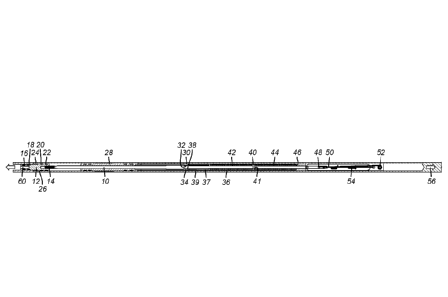Some of the information on this Web page has been provided by external sources. The Government of Canada is not responsible for the accuracy, reliability or currency of the information supplied by external sources. Users wishing to rely upon this information should consult directly with the source of the information. Content provided by external sources is not subject to official languages, privacy and accessibility requirements.
Any discrepancies in the text and image of the Claims and Abstract are due to differing posting times. Text of the Claims and Abstract are posted:
| (12) Patent: | (11) CA 3033348 |
|---|---|
| (54) English Title: | LOW PROFILE REMOTE TRIGGER FOR HYDROSTATICALLY SET BOREHOLE TOOLS |
| (54) French Title: | DECLENCHEUR A DISTANCE A TAILLE REDUITE POUR OUTILS DE FORAGE A REGLAGE HYDROSTATIQUE |
| Status: | Granted |
| (51) International Patent Classification (IPC): |
|
|---|---|
| (72) Inventors : |
|
| (73) Owners : |
|
| (71) Applicants : |
|
| (74) Agent: | MARKS & CLERK |
| (74) Associate agent: | |
| (45) Issued: | 2021-05-25 |
| (86) PCT Filing Date: | 2017-08-09 |
| (87) Open to Public Inspection: | 2018-02-15 |
| Examination requested: | 2019-02-07 |
| Availability of licence: | N/A |
| (25) Language of filing: | English |
| Patent Cooperation Treaty (PCT): | Yes |
|---|---|
| (86) PCT Filing Number: | PCT/US2017/046091 |
| (87) International Publication Number: | WO2018/031651 |
| (85) National Entry: | 2019-02-07 |
| (30) Application Priority Data: | ||||||
|---|---|---|---|---|---|---|
|
A pin whose movement triggers setting of the borehole tool, is initially held by a collet that is supported off a surrounding housing. A spring is supported off the pin and would push a housing that locks the collet to the pin axially to unsupport the collet but for the presence of a Kevlar® wire that has an associated heater. The wire pulls the housing that locks the collet against the spring bias and has an end attached to the pin. Melting the wire allows the spring to move the housing that traps the collet to the pin. At that point hydrostatic pressure can move the pin to either open a port on the borehole tool to set it hydro statically or to move an actuation rod attached to the pin to set the borehole tool mechanically or with a combination of mechanical and hydraulic force.
Selon la présente invention, une broche dont le mouvement déclenche la mise en place de l'outil de forage est initialement maintenue par une pince qui est soutenue par un boîtier environnant. Un ressort est soutenu depuis la broche et pousse un boîtier qui bloque axialement la pince sur la broche pour libérer la pince à l'exception de la présence d'un fil en Kevlar ® qui comporte un dispositif de chauffage associé. Le fil tire le boîtier qui bloque la pince contre la sollicitation du ressort et comporte une extrémité fixée à la broche. La fusion du fil permet au ressort de déplacer le boîtier qui piège la pince sur la broche. À ce stade, la pression hydrostatique peut déplacer la broche soit pour ouvrir un orifice sur l'outil de forage pour le régler de façon hydrostatique soit pour déplacer une tige d'actionnement fixée à la broche pour régler l'outil de forage mécaniquement ou avec une combinaison de force mécanique et hydraulique.
Note: Claims are shown in the official language in which they were submitted.
Note: Descriptions are shown in the official language in which they were submitted.

For a clearer understanding of the status of the application/patent presented on this page, the site Disclaimer , as well as the definitions for Patent , Administrative Status , Maintenance Fee and Payment History should be consulted.
| Title | Date |
|---|---|
| Forecasted Issue Date | 2021-05-25 |
| (86) PCT Filing Date | 2017-08-09 |
| (87) PCT Publication Date | 2018-02-15 |
| (85) National Entry | 2019-02-07 |
| Examination Requested | 2019-02-07 |
| (45) Issued | 2021-05-25 |
There is no abandonment history.
Last Payment of $210.51 was received on 2023-07-21
Upcoming maintenance fee amounts
| Description | Date | Amount |
|---|---|---|
| Next Payment if standard fee | 2024-08-09 | $277.00 |
| Next Payment if small entity fee | 2024-08-09 | $100.00 |
Note : If the full payment has not been received on or before the date indicated, a further fee may be required which may be one of the following
Patent fees are adjusted on the 1st of January every year. The amounts above are the current amounts if received by December 31 of the current year.
Please refer to the CIPO
Patent Fees
web page to see all current fee amounts.
| Fee Type | Anniversary Year | Due Date | Amount Paid | Paid Date |
|---|---|---|---|---|
| Request for Examination | $800.00 | 2019-02-07 | ||
| Registration of a document - section 124 | $100.00 | 2019-02-07 | ||
| Registration of a document - section 124 | $100.00 | 2019-02-07 | ||
| Application Fee | $400.00 | 2019-02-07 | ||
| Maintenance Fee - Application - New Act | 2 | 2019-08-09 | $100.00 | 2019-07-31 |
| Maintenance Fee - Application - New Act | 3 | 2020-08-10 | $100.00 | 2020-07-21 |
| Final Fee | 2021-04-07 | $306.00 | 2021-03-29 | |
| Maintenance Fee - Patent - New Act | 4 | 2021-08-09 | $100.00 | 2021-07-21 |
| Maintenance Fee - Patent - New Act | 5 | 2022-08-09 | $203.59 | 2022-07-21 |
| Maintenance Fee - Patent - New Act | 6 | 2023-08-09 | $210.51 | 2023-07-21 |
Note: Records showing the ownership history in alphabetical order.
| Current Owners on Record |
|---|
| BAKER HUGHES, A GE COMPANY, LLC |
| Past Owners on Record |
|---|
| None |